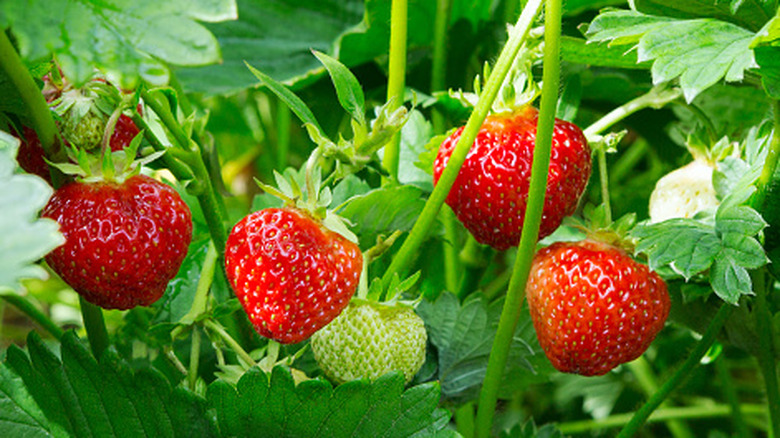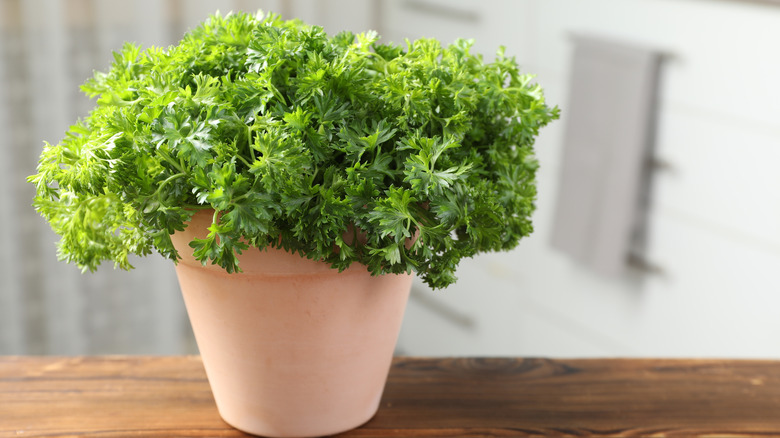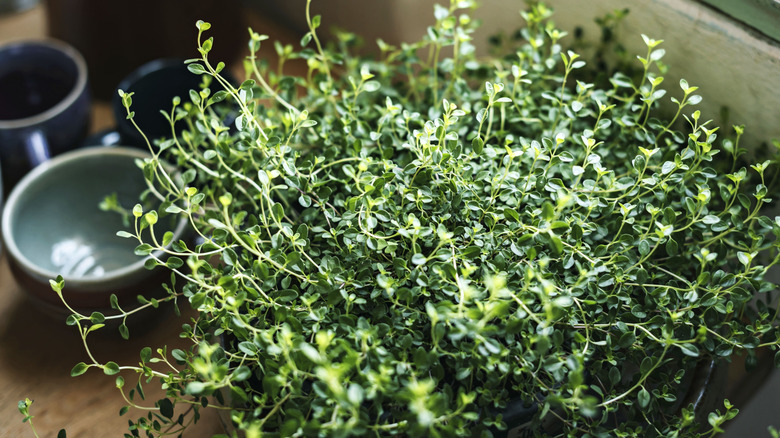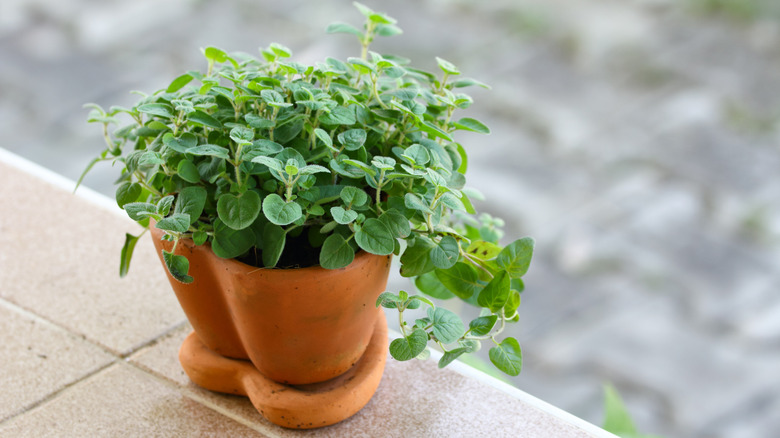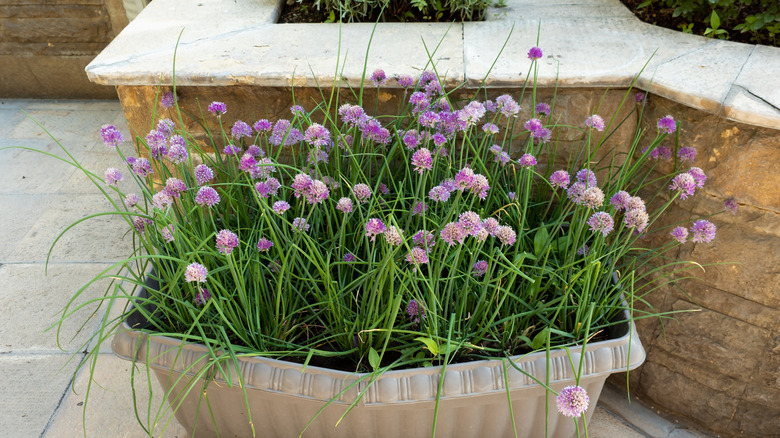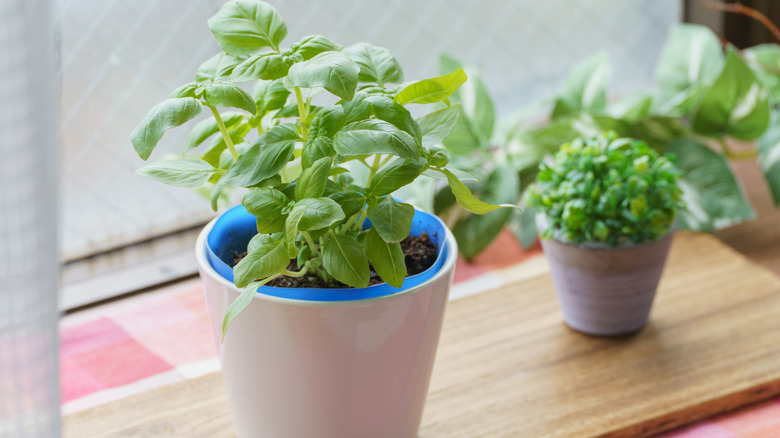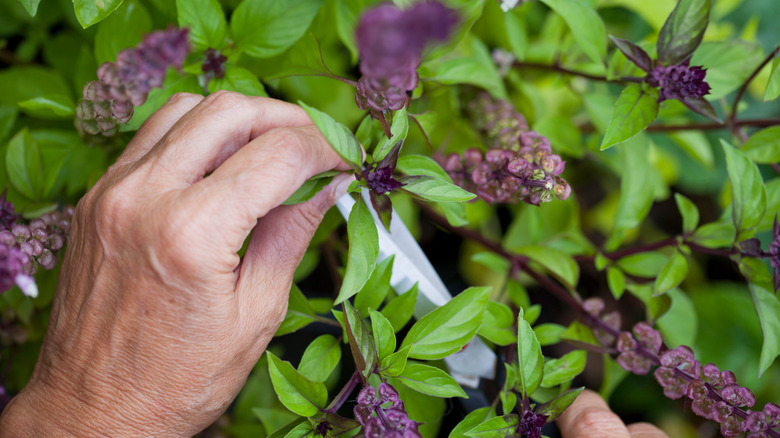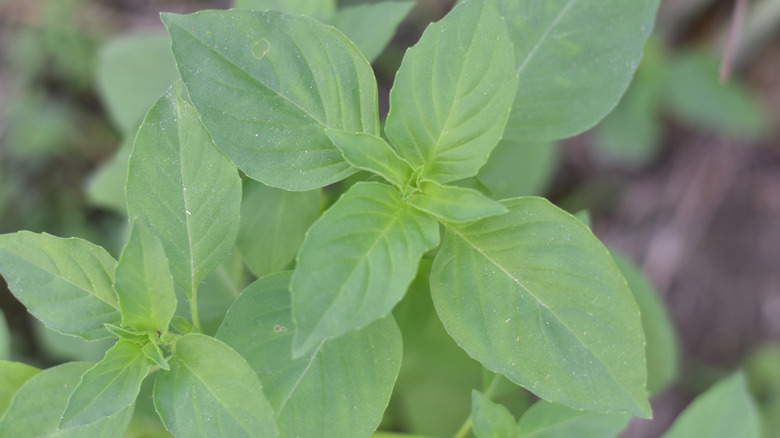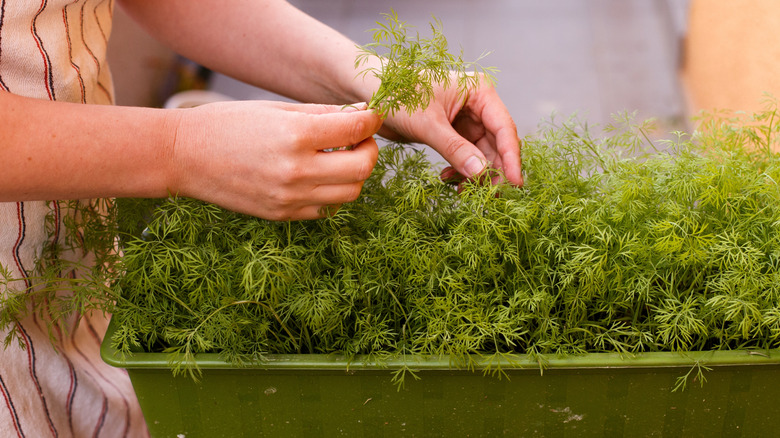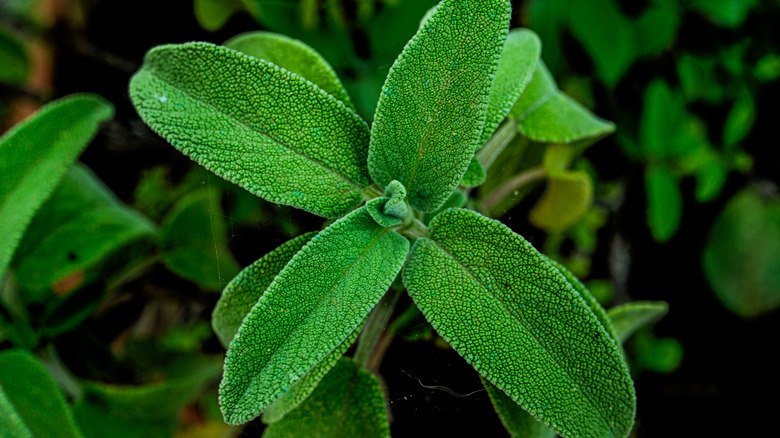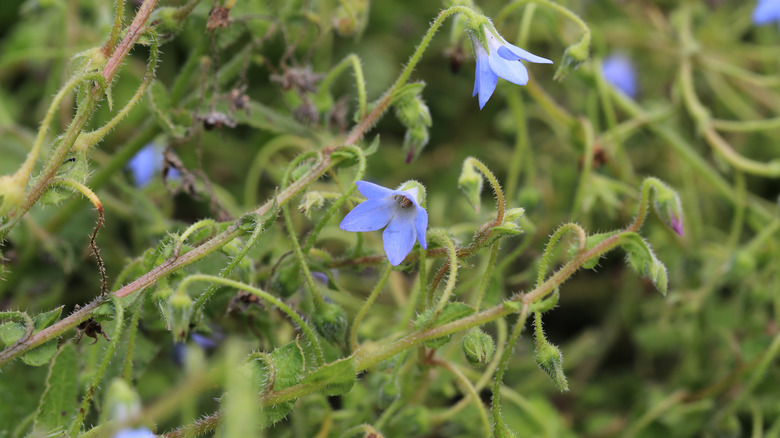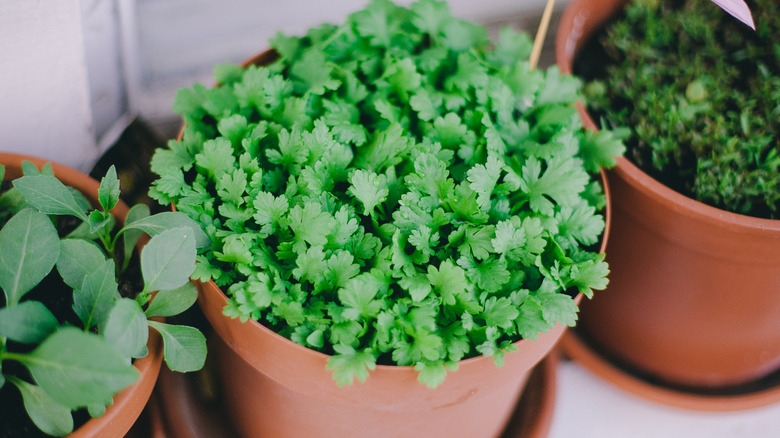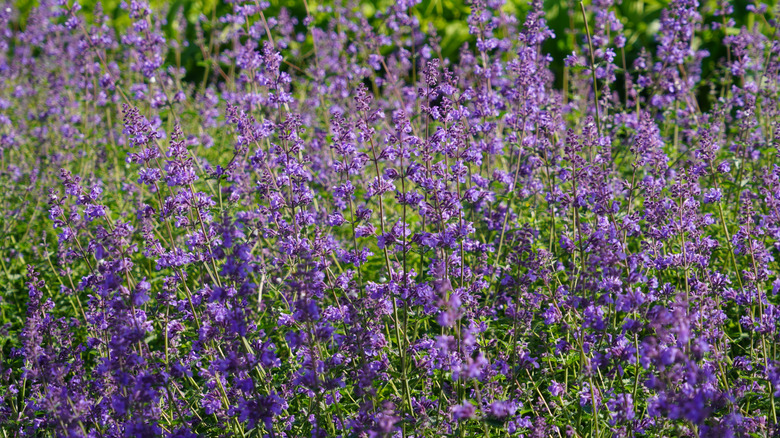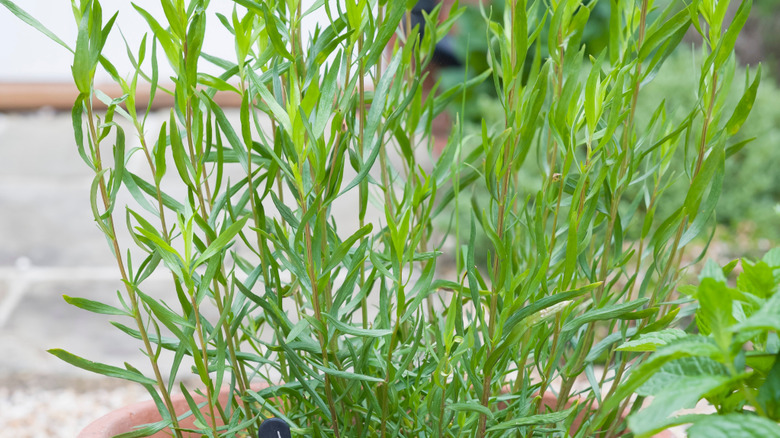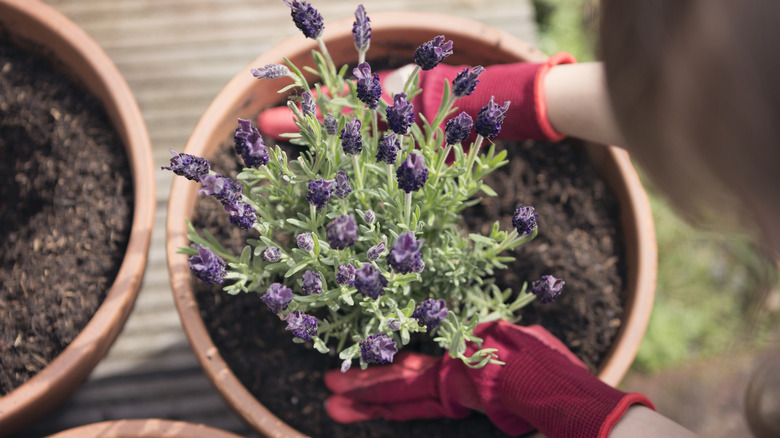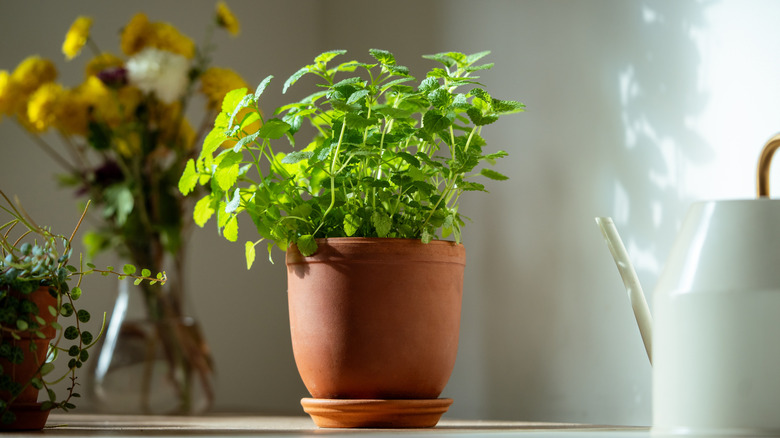16 Herbs You Should Be Growing With Your Potted Strawberries
We may receive a commission on purchases made from links.
Growing potted strawberries in your outdoor space can provide you with a luscious crop of sweet, juicy berries to enjoy all summer long. It's even easier if you grow these in one of those strawberry pots that has multiple planting pockets. But don't just stop there! You can easily create a small potted garden full of delicious berries alongside a nutritious selection of herbs, all in the same container. This is perfect if you have limited space and want to grow as much variety as you can.
Traditionally, strawberry pots are made from terracotta, and each one will have six or more planting pockets around the sides, plus the larger planting hole at the top. However, you can also get plastic, stackable strawberry planters, like this Mr. Stacky 5-Tier Strawberry Planter Pot. Of course, you don't just have to use this type of planter to grow your strawberries and herbs together. You can use any other type of large pot with good drainage holes or even a hanging planter for your mini garden. No matter which container you choose, you can easily end up with a productive fruit and herb garden that can thrive in a sunny spot on your patio or balcony and provide you with a continuous harvest. Ideally, you want to choose herbs that don't grow too large and that are fairly shallow-rooted, such as parsley, thyme, oregano, chives, and basil.
Parsley
Growing parsley in the same container as your strawberries is perfect because the plants don't get too large, and you can continually harvest those nutritious leaves to keep the plants more compact. Curly leaf parsley (Petroselinum crispum) would look particularly attractive, but you could also consider a flat leaf variety if you prefer. Remember that parsley is a biennial plant, which means that it has a two-year lifespan and will produce flowers in its second year. These will attract pollinators and help your strawberries produce more fruit.
Thyme
Common thyme (Thymus vulgaris) will grow happily in the same pot as your strawberries, and the different types of foliage will make quite an attractive display. This pairing is also ideal for a hanging planter because you can just let the thyme spill gently down the sides. All you'll want to do is harvest it regularly to keep the plant tidy and compact. The pretty flowers that thyme produces in spring and summer will also attract those pollinators that your strawberry plants will benefit from.
Oregano
Another attractive and aromatic herb you can add to your strawberry planter is oregano (Origanum vulgare). The small leaves of this delicious herb will add an interesting aesthetic, and the fragrant, edible flowers will attract bees and butterflies when they bloom. You can even attract beneficial insects by growing oregano in your garden, which will feed on those annoying pests. The strong scent of the oregano may also mask the sweet smell of the strawberries and help to keep pests away. This combination is perfect in a hanging planter, as the oregano will happily spill down over the sides.
Chives
You can add some interesting texture to your strawberry planter by growing chives (Allium schoenoprasum) in the middle of a large pot and then putting your strawberry plants around the outer edges. Chives have a strong onion aroma, which is known to repel certain pests, thus keeping your berries safe. Plus, the pretty globular flowers will help to attract those much-needed pollinators. Chives are also one of the best indoor herbs for your kitchen garden, so you can easily divide the clump if it gets too big, and pot up the excess plants to put on your kitchen windowsill.
Sweet Basil
Sweet basil (Ocimum basilicum) is perfect for growing in your strawberry planter along with your berries and other herbs. Just don't forget to water it, because, like strawberries, basil does appreciate ample amounts of moisture. You could make an attractive and aromatic display by planting basil in the center of your pot and then positioning the strawberries as fillers around the edges. The aromatic properties of basil can help to repel any pests that might be attracted to your strawberries, so you can enjoy all the delicious berries you want.
Cinnamon basil
Because you can never have too much basil, you might also like to grow cinnamon basil (Ocimum basilicum 'Cinnamon), which has purple stems and flowers, as well as a strong cinnamon aroma. As you probably already know, there are many common household pests that don't stand a chance against cinnamon, so your strawberries will benefit from this extra protection, as it's believed that the strong aroma will repel a number of common pests. The pretty flowers and vibrant purple stems will add a nice contrast to your strawberry plants.
Lemon basil
For even greater variety, you might also like to add lemon basil (Ocimum basilicum 'Lemon') to your potted strawberries. It contains citral and limonene, giving it a strong lemon scent, although the flavor is quite mild. It's common for strongly lemon-scented plants such as lemongrass and citronella to deter pests, so this fragrant herb could also be effective to keep your strawberries safe from anything that might like to feast on the fruits. Plus, you'll want to plant this delicious herb to attract more bees to your garden.
Dill
Common dill (Anethum graveolens) is quite an attractive plant with its fine, feathery foliage and aromatic fragrance. It will look amazing when paired with strawberries in the same container. For a regular pot, plant your dill in the center and your strawberries around the edges. There's even a dwarf variety available (Anethum graveolens 'Nano'), which is nice and compact if you decide to use one of those strawberry pots with the side pockets. It reaches a maximum height of 24 inches. As this variety doesn't transplant well, you'll want to grow it from seed right in your chosen pot.
Culinary sage
Culinary sage (Salvia officinalis) is another attractive plant that pairs really well with strawberries in your mini garden. Its lovely soft gray-green leaves will create an interesting texture, and the beautiful blooms will add a splash of color. There's also a dwarf variety (Salvia officinalis 'Dwarf') that is quite compact, maxing out at a height of around 24 inches. If you let this beauty bloom, it will attract plenty of pollinators to help your strawberries produce those juicy, red berries. This upright herb is perfect as the thriller in your container, with your strawberry plants around the edges.
Borage
If you've been gardening for a while, you'll know how beneficial borage (Borago officinalis) is in attracting pollinators to your garden. Standard borage can grow quite large, so it's best suited to growing in the center of a good-sized pot with strawberries around the edges and perhaps some thyme as the spiller. However, if you want a more compact plant, you might want to consider growing pygmy borage (Borago pygmaea), which only grows to a height of around 12 inches. It has pretty blue star-shaped flowers that are edible, as are the leaves, which have a lovely cucumber flavor.
Cilantro
Cilantro (Coriandrum sativum) is another popular herb often used in Asian dishes. This aromatic plant is quite good at repelling certain common pests while also attracting beneficial predatory insects, such as lacewings, ladybugs, hoverflies, and parasitoid wasps. The more of these beneficial garden visitors you have, the less you'll have to rely on other less eco-friendly methods to keep pests at bay. As cilantro can grow to a height of 24 inches, you'll want to trim it often if you want to keep it more compact in your planter.
Catmint
If you have a feline in your household, you might want to add a variety of catmint to your fruit and herb planter. As an alternative to regular catmint (Nepeta cataria), Proven Winners has released a dwarf variety known as Nepeta 'Cat's Pajamas', which only grows to a height of 14 inches, and has the most stunning purple flowers. This more diminutive plant will add a gorgeous splash of color to your potted strawberries and will bloom for an extended period, especially if you cut it back regularly.
French tarragon
Although not one of the more common herbs you might be familiar with, French tarragon (Artemisia dracunculus 'Sativa') is a delicious variety you might like to add to your strawberry planter. It grows to a height of 24 inches, but like most herbs, you can keep it more compact by shearing it regularly to use the flavorful leaves in your cooking. It's most commonly used in sauces, dressings, and egg dishes. French tarragon will complement your strawberries by providing yet another defense against pests.
Lavender
No herb planter would be complete without lavender, and this gorgeous plant would make the perfect thriller in any mini garden. For a more compact planting, you might like to consider a special dwarf variety known as Lavandula angustifolia 'Wee One,' which has a mature height of only 10 inches. This makes it a superb addition to your potted strawberries, and you'll love the gorgeous purple flowers and lovely soft gray-green foliage. Lavender is excellent at attracting pollinators and has so many fragrant uses around the home.
Lemon balm
As a member of the mint family, lemon balm (Melissa officinalis) is best planted in a pot rather than in the ground because it can spread quite aggressively, so it really needs to be contained. You'll love the deliciously lemon-scented leaves in your cooking, and keeping the plant well-trimmed will help to control its growth. The flowers can repel certain pests, but they are also a favorite with pollinators, especially native bees. You can even grow lemon balm as a houseplant that will make your home smell amazing.
Sweet marjoram
Another herb that's not as common is sweet marjoram (Origanum majorana), which is a close cousin to oregano. It has a fairly compact growth habit of under 2 feet, but you should be able to keep it to a reasonable size for your strawberry planter by cutting it back often. The flowers, which will attract pollinators, are also edible and have a sweet but somewhat spicy flavor. Sweet marjoram is also one of those delicious herbs you can easily propagate from cuttings, so you'll always have additional plants when you need them.
